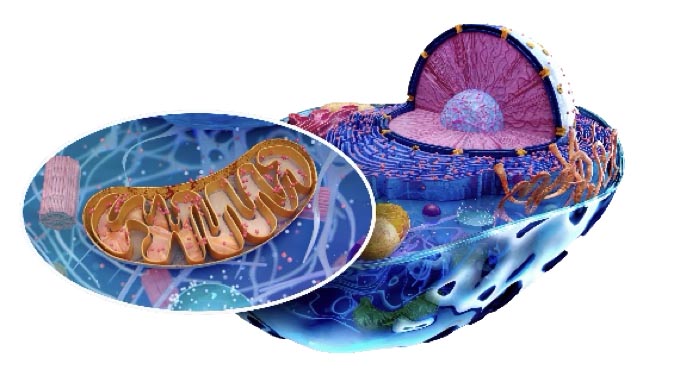
By: Prof. Dr. Seyed Saeid Zamanieh Shahri, MD and Prof. Dr. Sonia Sayyedalhosseini, MD
Therefore, the endoplasmic reticulum is a set of flat membrane-bound tubules and vesicles that is the material transport network in the cell. Attached to the outer surface of the rough endoplasmic reticulum are a large number of granular particles called ribosomes. Ribosomes have a ribonucleoprotein (RNA) structure plus protein and their function is to synthesize new protein molecules in the cell. Ribosomes are located in groups called polyribosomes or polysomes on the membrane of the rough endoplasmic reticulum. Therefore, the rough endoplasmic reticulum contains ribosomes, whose function is to synthesize proteins.
The smooth endoplasmic reticulum does not have ribosomes and for this reason they are called smooth endoplasmic reticulum. The function of the smooth endoplasmic reticulum is to synthesize lipid substances and participate in enzymatic processes. Steroids and fatty acids are made inside the smooth endoplasmic reticulum. This network is without ribosomal granules. The functions of the smooth endoplasmic reticulum include the synthesis of ribonucleoprotein (RNA) and the metabolism of xenobiotics. Xenobiotic is a foreign chemical substance that enters a biological system. The lipid synthesized in this part of the endoplasmic reticulum is stored in the cytoplasm as spherical droplets called spherosomes or amorphous oleosomes.
The Golgi complex or Golgi apparatus is an organelle with a smooth, double-walled surface that is a complex of channels, fine vesicles, large vacuoles, and wide sacs, and is therefore called the Golgi complex. This apparatus is usually located above the nucleus and next to the centrosome and is closely associated with the endoplasmic reticulum. The Golgi apparatus has membranes similar to those of the rough endoplasmic reticulum. This apparatus is very prominent in secretory cells. The Golgi apparatus functions in conjunction with the endoplasmic reticulum.
Endoplasmic reticulum vesicles are continuously detached from the endoplasmic reticulum and fuse with the Golgi apparatus, and in this way, materials are transferred from the endoplasmic reticulum to the Golgi apparatus. These transported materials are then processed in the Golgi complex and secretory vesicles, lysosomes, or other cytoplasmic components are formed.
*Ribosome: Ribosomes are small, round, dense particles of ribonucleoprotein that are located inside the cytoplasm on the outer wall of the rough endoplasmic reticulum. The most important function of the ribosome is the protein synthesis of the cell, and for this function it translates the genetic codes. These codes determine the sequence of amino acids to make proteins.
The ribosome is a small spherical particle containing RNA plus protein that is responsible for the synthesis of the cell’s proteins. Genetic information for making proteins is carried from the nucleus to the ribosome via messenger RNA. The origin of ribosomes seems to be the nucleus.
The cell’s synthetic apparatus consists mainly of the endoplasmic reticulum, the Golgi complex, and the ribosomes. This device can synthesize and process proteins, fats, and sugars, and finally form secretory vesicles.
Lysosomes are a heterogeneous group of membrane-bound cytoplasmic organelles that are involved in the process of digestion or cell lysis. The name lysosome is derived from the words lysis (Lysis) meaning to dissolve and soma (Soma) meaning body. Lysosomes contain a large number of enzymes and non-enzymatic substances and may be in the form of granules, vacuoles or vesicles. Lysosomal enzymes are initially synthesized within the rough endoplasmic reticulum and transported to the Golgi apparatus, where they are packaged and released as vesicles lysosomes. Lysosomes form the digestive tract of the cell because they allow the cell to digest damaged intracellular structures, food particles ingested by the cell, and unwanted substances such as bacteria. In short, lysosomes assist the cell in two important processes: endocytosis and exocytosis.

Endocytosis to receive substances and exocytosis to expel substances.
The uptake of materials, or endocytosis, into the cell occurs in two ways: pinocytosis and phagocytosis.
Pinocytosis is the only way for large macromolecules, such as protein molecules, to enter the cell. In this method, a small indentation is first created in the cell membrane, and anything that is in liquid form in the extracellular environment is placed in this indentation like a drop, which is called a pinosome or pinocytic vesicle (drinking cup). This cup and its contents soon join the lysosome, which is called fusion. At this stage, the materials in the drinking cup are broken down by lysosomal enzymes.
As mentioned in the previous section, there are two ways for cells to take in materials, or endocytosis: pinocytosis and phagocytosis. We talked about pinocytosis, now let’s describe phagocytosis:
Phagocytosis means eating a cell or eating a foreign body, and it is done in much the same way as pinocytosis, but in this process, large solid particles, such as bacteria or damaged cells, are eaten instead of molecules. Some cells, including macrophages and special white blood cells called polymorphonuclear (PMN), are responsible for taking in bacteria, damaged cells, and other foreign materials in this way. Therefore, very large particles enter the cell by a specific process of the cell membrane called endocytosis. Large macromolecules, such as protein molecules, enter the cell by pinocytosis, and large solid particles, such as bacteria, damaged cells, and foreign materials, enter the cell by phagocytosis. For example, when a macrophage, encounters a bacterium, it tries to capture the bacterium by forming a pseudopod and bringing it into its cytoplasm. In this case, it is called a phagosome or phagocytic vesicle or edible body. The cell then analyzes the edible body with the help of its own lysosomal enzymes.
Immediately after a pinocytic or phagocytic vesicle enters the cell, one or more lysosomes attach to it and empty their acid hydrolases into the vesicle. In this way, a digestive vesicle is formed in which the hydrolases, lysosomal enzymes, begin to hydrolyze the protein, carbohydrate, lipid, and other substances contained in the vesicle. The result of this digestion is the creation of small molecules such as amino acids, glucose, phosphate, etc., which can now diffuse through the vesicle membrane into the cytoplasm.
To be continued









































